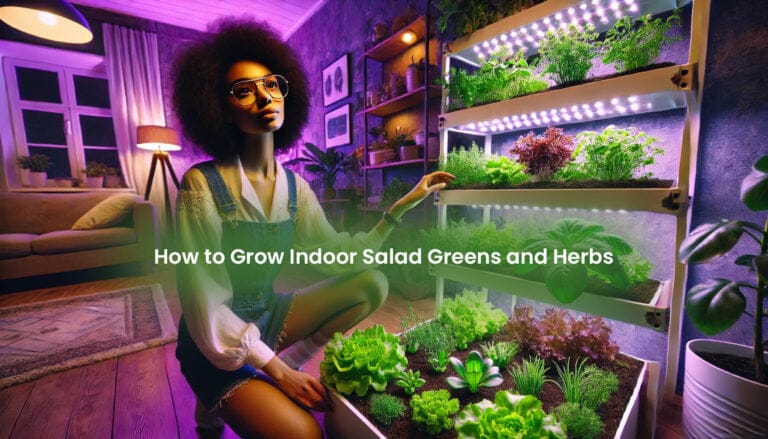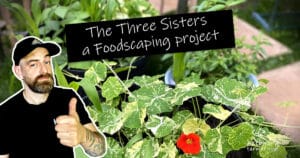Table of contents
Introduction
Growing indoor salad greens and herbs is like bringing a slice of nature into your home. Whether you’re in a snug flat or a sprawling manor, there’s something deeply satisfying about plucking fresh greens right from your windowsill, especially during those dreary British winters when the sun’s gone on holiday.
Not only do you get the joy of harvesting your own food—saving a few quid while you’re at it—but your indoor herb garden becomes a little oasis of green in an otherwise grey world. It’s like having a mini Eden, brightening up your space and your mood. Plus, let’s face it, knowing exactly what’s in your food (spoiler: no dodgy chemicals) gives you peace of mind.
Best Varieties of Salad Greens and Herbs for Indoor Growing
Picking out which salad greens and herbs to grow indoors is like choosing your favourite players for a football team. You want the best lineup that will thrive in your conditions.
Variety Comparison Table
| Variety | Growth Rate | Flavour Profile | Space Requirements | Ideal Growing Conditions |
|---|---|---|---|---|
| Butterhead Lettuce | Fast | Mild, sweet | Compact | Moderate light, cool temperatures |
| Rocket (Arugula) | Moderate | Peppery, spicy | Requires more space for spreading | High light, cool to moderate temperatures |
| Spinach | Moderate | Mild, slightly sweet | Compact | Low to moderate light, cool temperatures |
| Baby Leaf Spinach | Fast | Tender, mild | Very compact | Moderate light, consistent moisture |
| Mini Lettuce | Moderate | Crisp, slightly bitter | Compact | High light, cool temperatures |
| Basil (Herb) | Fast | Sweet, aromatic | Compact | Warm temperatures, plenty of light |
| Mint (Herb) | Fast | Fresh, cool | Spreading, requires space | Cool, moist conditions |
| Parsley (Herb) | Moderate | Fresh, earthy | Compact | Moderate light, well-drained soil |
Pro Tip for Beginners: If you’re just starting out, go for the easy wins like lettuce or arugula, or herbs like basil and mint. These are the star players—reliable and straightforward. I remember my first batch of lettuce—it was like watching your kid win their first race.
Setting Up Your Indoor Herb and Salad Garden
Setting up your indoor herb and salad garden is simpler than you might think. You don’t need a green thumb, just a bit of enthusiasm and maybe a dash of patience. Let’s crack on, shall we?
- Containers: Opt for shallow trays or pots. Vertical planters are my go-to—they save space and look cracking in the kitchen. Self-watering planters? Brilliant for your homegrown herbs indoors.
- Growing Medium: Whether you choose soil or soilless mix, make sure it’s packed with nutrients. Coconut coir’s a winner in my book—light, airy, and holds water like a champ.
- Light Requirements: Natural sunlight is grand if you’ve got it, but if not, LED grow lights are the next best thing. They’re a godsend in extending your growing season. Need help picking the best ones? Check out our guide on the Best LED Grow Lights for Indoor Gardens in 2024.
- Temperature and Humidity: Keep things cool—around 10-20°C is ideal. Your plants appreciate a bit of humidity too, so a gentle mist now and then works wonders.
Creating a Green Haven: Beyond just growing your indoor lettuce and herbs, think about how they add to your space. I’ve found that mixing salad greens with other houseplants creates a lush, green corner that lifts the spirits every time I pass by.
Planting and Caring for Your Indoor Salad Greens and Herbs
Here’s where the magic happens—planting your seeds. Let’s get those hands dirty.
- Seed Sowing: Sow the seeds lightly and cover them just enough to keep them cozy.
- Watering: Keep the soil moist, but not drowning. Think of it like a well-made cuppa—not too much, not too little.
- Fertilization: Every few weeks, give your greens and herbs a little treat with organic liquid fertilizer. Trust me, they’ll repay you with lush, vibrant leaves.
Harvesting and Using Your Indoor Greens and Herbs
This is what you’ve been waiting for—the harvest. It’s like Christmas morning, but better because you get fresh salad!
- Harvest Time: Your greens are good to go when they’re about 10-15 cm tall. For herbs like basil, wait until they have several sets of leaves. Don’t dally—they’re best when young and tender.
- Cut and Come Again: My favourite method. Snip off what you need, and the plant keeps on giving. It’s the gift that keeps on giving!
- Using Your Greens and Herbs: Fresh greens aren’t just for salads, and herbs aren’t just for garnishing. Try tossing them into smoothies, layering them in sandwiches, or adding them to wraps. Your meals will be bursting with freshness.
Troubleshooting Common Issues in Your Indoor Herb Garden
Even the best gardeners hit a snag now and then, but don’t fret—I’ve got your back.
- Pests: Spot yellowing leaves or tiny insects? Time to act. A quick spray with organic insecticidal soap usually sorts things out.
- Mould/Mildew: These can be pesky, but good air circulation and careful watering can keep them at bay. If you spot any, snip off the affected leaves.
- Slow Growth: If your greens and herbs seem sluggish, check your light levels and make sure they’re getting enough nutrients. Sometimes all they need is a little tweak to get going again.
Common Issues Table
Here’s a quick reference for some common issues:
| Issue | Symptoms | Solutions |
|---|---|---|
| Pests (Aphids, Mites) | Yellowing leaves, visible insects | Use organic insecticidal soap, introduce beneficial insects |
| Mould/Mildew | White or grey fuzzy growth | Improve ventilation, reduce humidity, remove affected leaves |
| Slow/Stunted Growth | Small or yellowing plants | Check light levels, adjust watering, ensure nutrient-rich soil |
| Overwatering | Wilting, root rot | Reduce watering, ensure proper drainage |
| Lack of Light | Leggy, pale plants | Increase exposure to grow lights or natural light |
Conclusion
Growing indoor salad greens and herbs is one of the best decisions you’ll make. Not only will you enjoy fresh, delicious greens year-round, but you’ll also add a touch of nature to your home that’s both beautiful and practical. So roll up your sleeves and get planting—you’ll be amazed at how rewarding it is!
Remember, gardening is as much about the journey as it is the harvest. Enjoy each step, from the first seed you sow to the last leaf you pick. Happy gardening!





